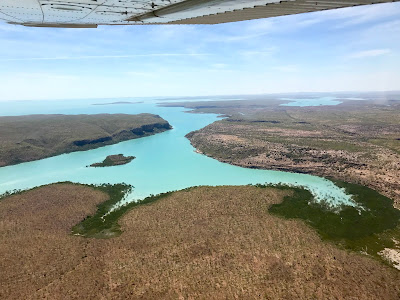After a pleasant two nights at Arkaroola it was time to embark on the last flights of this trip.
We left Arkaroola early for the short flight to Broken Hill so we could spend the afternoon looking around there.
On the leg to Broken Hill we crossed the beautiful Lake Frome but, unfortunately, it had no water in it so we missed out on seeing the lovely pinks and blues exhibited when water is present. However, we did cross the dog fence which stretches for miles along the South Australia / New South Wales border. It’s always fun to drop down (to 500ft of course) to fly along the few miles of this iconic fence that stops feral animals from getting into the farmland of New South Wales,
My son Andrew had arranged for us to meet Neil Taylor who is a Flying Doctor Pilot at the Broken Hill base and we enjoyed a tour of the base with Neil. It was Neil’s day off and, he was prepared to show us over an aircraft but they were all out on jobs - bugger. The RFDS does a fantastic job in the outback and are a vital service that is well regarded by all Australians.
We hired a rental car and went out to Silverton where Mad Max, Razorback and A Town Like Alice was filmed and also visited the Pro Hart gallery and the Miners Memorial at the top of the now decommissioned Broken Hill lead and zinc mine.
Andrew is a First Officer with Rex Airlines and months ago had asked to operate the evening flight into Broken Hill so he could meet up and spend the evening with us. That wasn’t to be which was disappointing. One of Rex’s Saab 340 aircraft had broken down earlier in the day and disrupted the schedules. Andrew did get to Broken Hill as planned but then had to promptly crew the aircraft back to Adelaide again. Bugger - so close but so far.
The following morning Simon and I said goodbye to Shelley and Pete who have accompanied us in their Cessna 182 for much of our trip. Their last flight was to Camden (south of Sydney) and we had to return to Bathurst. We’ve had so much fun with Shelley and Pete on this trip. They’re great company and easy to get on with. I’ve done several trips with them in Australia and South Africa and hope to do many more.
On our flight back to Bathurst we had a stonking tailwind and our little Cessna 172 was blown along at a paint-blistering 150kts at times. On our track was a little town called Condobolin that we called in to stretch our legs, empty the bladder and swap pilots.
It was my duty to fly the last leg into Bathurst to return VH-BAC. During the last 30mins we encountered some decent turbulence and VH-BAC bucked and kicked. I'm sure she was resisting going home.
During our travels we must have flown through most of the bugs in Australia that had become baked onto the leading edges and VH-BAC’s fuselage was coated in the fine red dust that’s prevalent in the outback. On a warm afternoon it was good to give her a well deserved wash before handing the keys back to the Bathurst Aero Club.
During the last 19 days we’ve enjoyed beautiful flying conditions in clear blue skies and lovely warm temperatures. Most of the time we’ve enjoyed tailwinds or no wind and, although we’ve flown 4,571nm / 8,465km in a total of 50hrs none of the flights have seemed to drag. Flying with Simon has been great, we’ve had many laughs and I’ve really enjoyed his company. I’ve learned a lot from Simon and hope he also was able to take something away from this trip.
Flying in Australia is so different from flying in New Zealand. Yes, the laws of aerodynamics are the same and the procedures we use are similar, but the country is vast, the distances are huge and the scenery (particularly in he Kimberley) is pure artwork. We are blessed to be able to fly in New Zealand but I love the magnificent desolation here just as much.
Flying in Australia is so different from flying in New Zealand. Yes, the laws of aerodynamics are the same and the procedures we use are similar, but the country is vast, the distances are huge and the scenery (particularly in he Kimberley) is pure artwork. We are blessed to be able to fly in New Zealand but I love the magnificent desolation here just as much.
Until next time ...
Final team photo before departing Broken Hill
(Simon, Shelley, Pete & me in front of C182 VH-BMJ)
|
Departing Broken Hill
|
Simon concentrating on the needles
|
The dusty land gives way to farms as we approach Bathurst
|
A wide approach into Bathurst to stretch our last flight just that wee bit longer
|
It’s a tradition of mine to say thank you to any aircraft that has transported me safely on a fantastic trip. If you look after and appreciate an aircraft, it will look after you.
|





















































